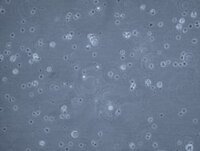SCC223 Sigma-AldrichTHP-1 NF-kappaB-eGFP Human Acute Monocytic Leukemia Cell Line
THP-1 NF-κB-eGFP cell line provides a simple method for detecting common microbial contaminants and is suitable for both routine assays and high throughput screening of biological cultures.
More>> THP-1 NF-κB-eGFP cell line provides a simple method for detecting common microbial contaminants and is suitable for both routine assays and high throughput screening of biological cultures. Less<<Recommended Products
Overview
| Replacement Information |
|---|
| References |
|---|
| Product Information |
|---|
| Biological Information | |
|---|---|
| Cell Line Type |
|
| Physicochemical Information |
|---|
| Dimensions |
|---|
| Materials Information |
|---|
| Toxicological Information |
|---|
| Safety Information according to GHS |
|---|
| Safety Information |
|---|
| Product Usage Statements | |
|---|---|
| Quality Assurance | • Each vial contains ≥ 1X10⁶ viable cells. • Cells are tested negative for infectious diseases by a Human Essential CLEAR panel by Charles River Animal Diagnostic Services. • Cells are verified to be of human origin and negative for inter-species contamination from rat, mouse, chinese hamster, Golden Syrian hamster, and non-human primate (NHP) as assessed by a Contamination CLEAR panel by Charles River Animal Diagnostic Services. • Cells are negative for mycoplasma contamination. • Each lot of cells is genotyped by STR analysis to verify the unique identity of the cell line. |
| Usage Statement |
|
| Packaging Information | |
|---|---|
| Material Size | ≥1X10⁶ cells/vial |
| Transport Information |
|---|
| Supplemental Information |
|---|
| Specifications |
|---|
| Global Trade Item Number | |
|---|---|
| Catalog Number | GTIN |
| SCC223 | 04061842403462 |
Documentation
THP-1 NF-kappaB-eGFP Human Acute Monocytic Leukemia Cell Line SDS
| Title |
|---|
Data Sheet
| Title |
|---|
| Data Sheet-SCC223 |
| THP-1 NF-κB-eGFP Human Acute Monocytic Leukemia Cell Line |











 Antibody[223363-ALL].jpg)







